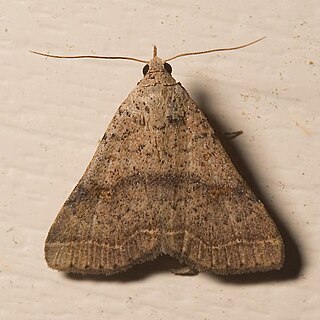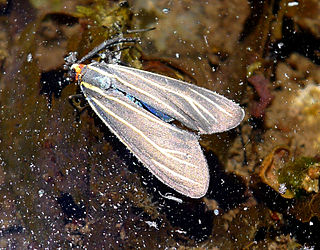
Cosmosoma is a genus of tiger moths in the subfamily Arctiinae. The genus was erected by Jacob Hübner in 1823.

Erruca is a genus of tiger moths in the subfamily Arctiinae erected by Francis Walker in 1854. Most species were formerly included in the genera Cosmosoma or Mallodeta.

Bleptina is a genus of litter moths of the family Erebidae. It was erected by Achille Guenée in 1854.

Chetone angulosa is a moth of the family Erebidae. It was described by Francis Walker in 1854. It is found in Central America and northern South America, including Venezuela, Guatemala, Belize, Panama and Costa Rica.
Cosmosoma subflamma is a moth of the subfamily Arctiinae. It was described by Francis Walker in 1854. It is found in Brazil and on Santa Lucia.

Cosmosoma myrodora, the scarlet-bodied wasp moth, is a moth of the subfamily Arctiinae. It was described by Harrison Gray Dyar Jr. in 1907. It is found in the United States in Florida and from South Carolina to Texas. The habitat consists of coastal plains.
Cosmosoma admota is a moth of the family Erebidae. It was described by Gottlieb August Wilhelm Herrich-Schäffer in 1854. It is found in the Brazilian states of Pernambuco, Bahia and Espírito Santo.
Cosmosoma annexa is a moth of the family Erebidae. It was described by Gottlieb August Wilhelm Herrich-Schäffer in 1854. It is found in Rio de Janeiro, Brazil.
Cosmosoma braconoides is a moth of the family Erebidae. It was described by Francis Walker in 1854. It is found in Mexico and Honduras.
Cosmosoma centralis is a moth of the family Erebidae. It was described by Francis Walker in 1854. It is found in Brazil.
Cosmosoma consolata is a moth of the family Erebidae. It was described by Francis Walker in 1856. It is found in Brazil.
Cosmosoma flavitarsis is a moth of the family Erebidae. It was described by Francis Walker in 1854. It is found in Colombia and Venezuela.

Cosmosoma impar is a moth of the family Erebidae. It was described by Francis Walker in 1854. It is found in Mexico,
Cosmosoma remota is a moth of the subfamily Arctiinae. It was described by Francis Walker in 1854. It is found in Venezuela.
Cosmosoma telephus is a moth of the subfamily Arctiinae. It was described by Francis Walker in 1854. It is found in Colombia, Venezuela and Espírito Santo, Brazil.

Cosmosoma tengyra is a moth of the subfamily Arctiinae. It was described by Francis Walker in 1854. It is found in the Amazon region.

Cosmosoma teuthras is a moth of the subfamily Arctiinae. It was described by Francis Walker in 1854. It is found in Mexico, Guatemala, Costa Rica, Panama, Colombia, Venezuela and Brazil.

Ctenucha venosa, the veined ctenucha moth, is a moth of the family Erebidae. It was described by Francis Walker in 1854. It is found in the US from southern Nevada and Arizona to Colorado, Kansas, Oklahoma and Texas, as well as in Mexico, Guatemala, Panama and Venezuela.

Episcepsis inornata is a moth of the family Erebidae. It was described by Francis Walker in 1856. It is found in Central America. It has also been recorded from southern Texas.
Trischistognatha pyrenealis is a moth in the family Crambidae. It was described by Francis Walker in 1859. It is found in Mexico, Central America, the West Indies and the southeastern United States, where it has been recorded from Georgia to Florida and from Alabama to Texas.










